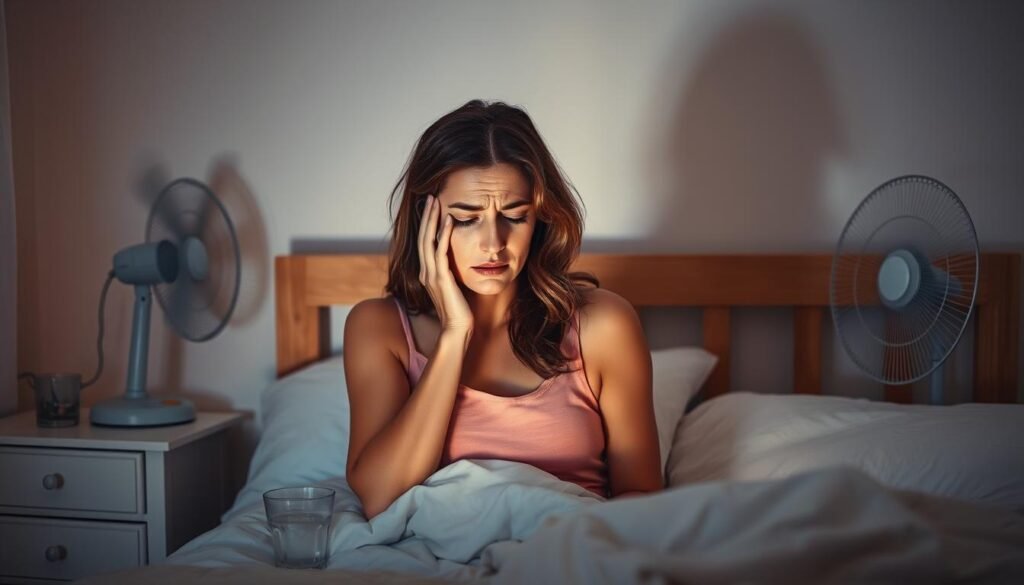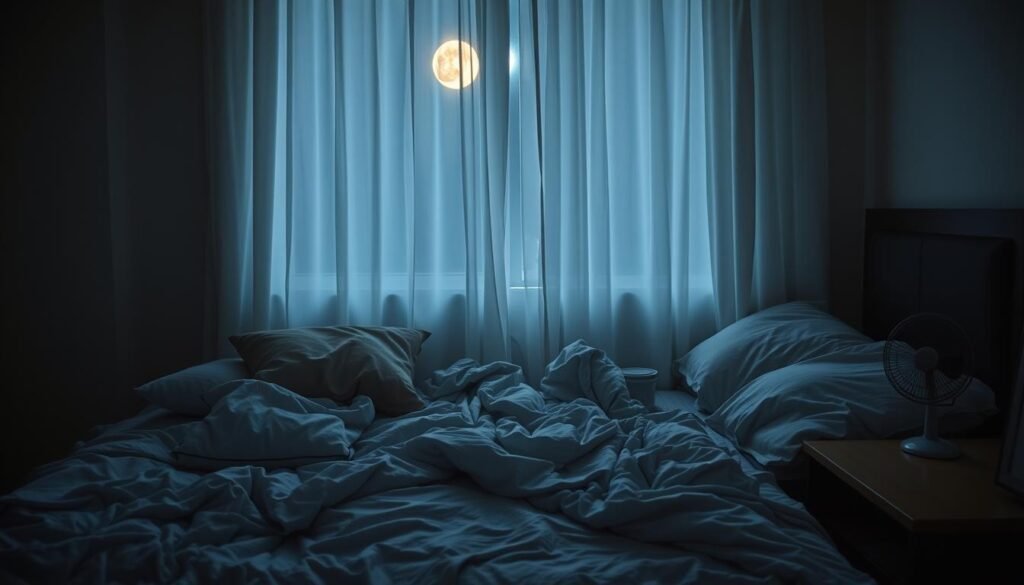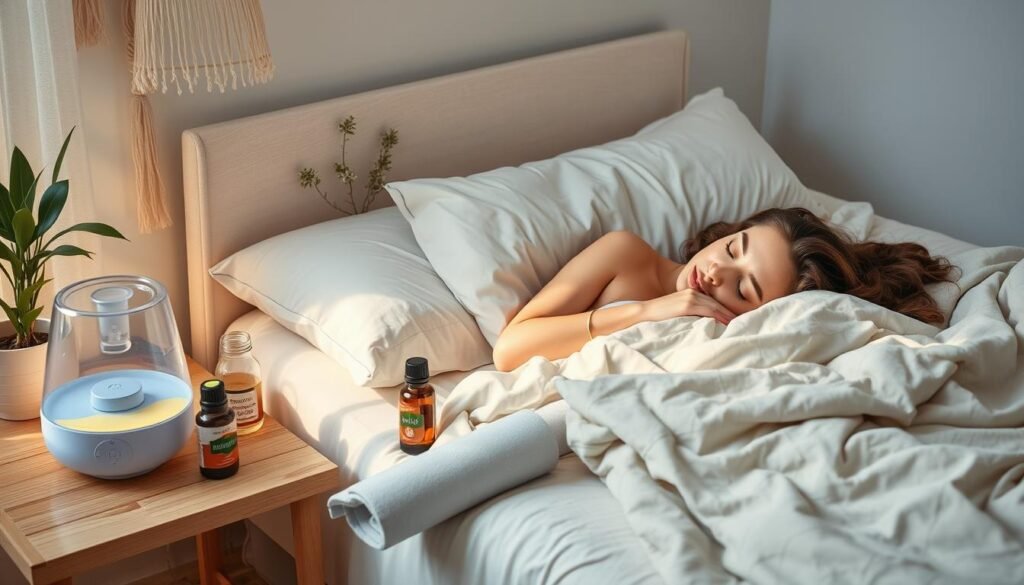Did you know about 75% of women get hot flashes during menopause? These hot flashes can mess with sleep, linking them closely to insomnia. It’s important to understand what causes both hot flashes and insomnia. This knowledge helps women manage this challenging time better. Menopause symptoms can change a lot in how strong and frequent they are. We’ll look at the hormone changes that cause these symptoms and share tips to help handle them.
Key Takeaways
- Hot flashes affect around 75% of women during menopause.
- Hormonal fluctuations are the primary cause of hot flashes and insomnia.
- Lifestyle changes can aid in managing hot flashes effectively.
- Prescription medications include hormone replacement therapy and non-hormonal options.
- Poor sleep can further exacerbate menopause symptoms.
- Cognitive behavioral therapy can improve sleep quality during menopause.
Understanding Hot Flashes
Hot flashes are sudden warmth feelings, often in the face, neck, and chest. They start quickly. They can make you sweat and look flushed. During menopause, they’re common, affecting many women’s lives.
Many women, up to 75%, feel hot flashes during perimenopause in the U.S. They can ruin sleep, leading to insomnia. Studies show that these episodes wake women up, affecting their sleep deeply.
After menopause, women are more likely to get sleep apnea, up to three times more. Poor sleep and hot flashes make a cycle of discomfort. It’s hard for some to escape it.
Hormone treatments help improve sleep during menopause. They ease the trouble caused by hot flashes. Also, some medications, like SSRIs and SNRIs, are good at making hot flashes less severe.
But, hot flashes may cause depression and anxiety, which disturb sleep. Managing these symptoms and their effect on sleep is a big challenge. It’s part of this natural life stage for women.
Menopause Symptoms Explained
Menopause marks a significant stage in a woman’s journey, usually happening by the age of 51. It marks the end of her menstrual cycles, tied to drops in hormone levels, especially estrogen. This phase can bring various symptoms, making it a tough period for many.
Some common signs are hot flashes, mood changes, and trouble sleeping. About 75% of women experience hot flashes during this time. For most, these hot flashes last two years or less. Smoking or being underweight can bring on menopause sooner. In contrast, overweight women may go through it later.
It’s important to know how hormonal shifts affect menopause. A lack of estrogen leads to hot flashes, mood swings, and sleep issues. Insomnia is common during menopause, often worsened by anxiety and depression linked to these changes.
Menopause can also cause sleep problems like sleep apnea and restless legs syndrome (RLS). Women who have surgery to remove their ovaries often face harsher symptoms. Hormone therapy can help ease the discomfort of hot flashes and improve sleep. This shows the deep effect menopause has on women’s health.
What Causes Hot Flashes and Insomnia?
To understand what causes hot flashes and insomnia, we need to look at menopause. When estrogen levels drop, the body undergoes many changes. These changes can cause discomfort and make it hard to sleep.
Hormonal Changes during Menopause
Menopause brings significant hormonal shifts, especially in estrogen levels. With less estrogen, the hypothalamus (which controls body temperature) reacts more to temperature changes. This reaction may lead to hot flashes. Around 75 to 85% of people in menopause experience hot flashes. Studies show that insomnia is common too, affecting daily life for about 26% of those in perimenopause and menopause.
Estrogen Deficiency and its Impact
Low estrogen is a big reason for insomnia during menopause. People with lower estradiol levels often have more sleep problems. Apart from hot flashes, night sweats, and an overactive bladder contribute to insomnia. Between 39 and 60% of women in menopause face sleep challenges. Keeping a cool sleeping area might help with these issues. Talking to doctors can lead to treatments like hormone replacement therapy, improving symptoms of low estrogen.
Recognizing the Symptoms of Hot Flashes
Knowing how to spot hot flash symptoms can truly help women during perimenopause and menopause. Many report different signs that change in strength. They often feel a quick heat wave, see red skin, feel their heart race, and sweat a lot. These can really make daily life and sleeping hard.
Physical Signs and Experiences
Hot flashes are very common, with most North American women saying they’ve had them. How severe hot flashes are can vary. Some are mild, while others are intense. Key physical signs include:
- Sudden warmth spreading throughout the body
- Increased sweating
- Flushed complexion, often characterized by redness
- Rapid heartbeat
It’s important to recognize these symptoms to find the right solutions. Writing down symptoms in a journal can help. It might show what triggers hot flashes.
Differences between Daytime and Nighttime Episodes
Day vs night symptoms can be different. Daytime hot flashes can happen anytime, often caused by stress, caffeine, or certain foods. Nighttime ones, or night sweats, disrupt sleep more.
About 39% to 47% of perimenopausal and 35% to 60% of postmenopausal women struggle with sleep due to night sweats. Knowing the difference helps in handling them better. Cool rooms and diets with plant estrogens, like soybeans and flaxseed, may lessen them. Advice on dealing with hot flashes and boosting well-being is available at sleep health blogs.

Night Sweats: A Common Companion
Night sweats are common for women going through menopause. This is often due to decreasing estrogen levels. Many feel these sweats in their late 40s and early 50s, which can disrupt their sleep. About 80% of women face hot flashes and night sweats during menopause.
These night sweats can mess with your sleep, making you tired and irritable. They’re disrupted by various things, like certain medications, low blood sugar, and different infections. Even your lifestyle can play a role.
- Common medications linked to night sweats include certain antidepressants and pain relievers.
- Underlying conditions such as hyperthyroidism or anxiety can amplify the occurrence of night sweats.
- Lifestyle changes can mitigate these symptoms. Options to consider include avoiding spicy foods and creating a comfortable sleeping environment.
It’s important to find out why night sweats happen. There are treatments, like hormone therapy or changing your lifestyle. Knowing this can help women handle menopausal symptoms better. It improves sleep quality and overall life.
Sleep Disturbances during Menopause
Many women face sleep disturbances during menopause. The issue gets worse due to hot flashes, affecting sleep. About 75%-85% of menopausal women experience hot flashes. These can disrupt sleep for around five years, causing discomfort and fatigue.
The Effects of Hot Flashes on Sleep Quality
Hot flashes harm sleep quality, with 61% of women reporting problems. A study found that 42% had sleep-affected hot flashes, and almost half had insomnia. This shows why treating hot flashes and sleep problems together is important.
Several factors make these sleep issues worse during menopause. A drop in estrogen levels leads to poor sleep. This gets worsened by the stress of insomnia, increasing anxiety. Cognitive behavioral therapy (CBT) is shown to help greatly with chronic insomnia, especially for those in menopause.
Mood swings, sleep issues, and cognitive problems create a tough cycle. It’s important for women to look into various treatments. Hormone replacement therapy (HRT) is a common choice for managing symptoms. Drugs like fluoxetine, paroxetine, and venlafaxine also help with hot flashes and sleep. Some prefer black cohosh, though its effectiveness is debated.

| Symptom | Occurrence Rate |
|---|---|
| Hot flashes | 75%-85% |
| Sleep problems | 61% |
| Insomnia symptoms | 60% |
| Hot flashes affecting sleep | 42% |
| Chronic insomnia treatment duration | More than 3 weeks |
Knowing how hot flashes and sleep issues connect helps women find effective treatments. By tackling these issues, they can sleep better and improve their quality of life during menopause.
Lifestyle Factors Affecting Sleep and Hot Flashes
Improving lifestyle choices can greatly reduce hot flashes and sleep problems during menopause. By choosing the right foods and being active, stress can be managed better. This leads to a better quality of life.
Impact of Diet and Exercise
Eating more plant-based foods and phytoestrogens can help with hot flashes and improve sleep. These dietary changes may make menopause easier to handle. Adding regular physical activity is key. It can lower hot flashes and make sleeping easier.
Women who exercise often face fewer sleep problems. This shows the positive effect of an active lifestyle on sleep.
The Role of Stress Management
Managing stress is crucial for lessening hot flashes and sleep issues. Mindfulness, yoga, and Cognitive Behavioral Therapy help in managing stress. These practices improve emotional health and reduce menopause-related insomnia.
Understanding what causes personal stress and getting support is important for sleep and health. For more on stress management benefits, visit this guide.
Treatment Options for Hot Flashes and Insomnia
There are many ways to tackle hot flashes and insomnia. Anyone with these symptoms should look at different treatments. Mixing therapies can help a lot.
Prescription Medications and Hormone Replacement Therapy
Hormone replacement therapy is top for menopause hot flashes. It combines estrogen with progesterone or progestin. This mix lessens the symptoms. But, it comes with risks like cancer and blood clots. Newer forms, like patches or gels, may reduce these risks.
Medicines have been approved for menopause symptoms. Paroxetine (Brisdelle), an SSRI, works well for hot flashes. Fezolinetant (Veozah) is new but good for strong hot flashes. For some, using hormone therapy with these drugs works best.
Non-Hormonal Alternatives
Options without hormones are becoming popular. SSRIs, gabapentin, and clonidine can help. Lifestyle changes are also important. Avoiding triggers, relaxing, and dressing in layers can help ease symptoms.
Finding the right treatment takes time. Healthcare providers are key in this hunt. Age, how severe the symptoms are, and health shape the plan. To learn more, visit Mayo Clinic.

| Treatment Type | Effectiveness | Risks | Suitable For |
|---|---|---|---|
| Hormone Replacement Therapy | High | Increased cancer risk | Women bothered by severe symptoms |
| Paroxetine (Brisdelle) | Moderate | Side effects of SSRIs | Women looking for non-hormonal options |
| Fezolinetant (Veozah) | High | Long-term effects still under review | Moderate to severe hot flashes |
| Lifestyle Modifications | Variable | None if practiced safely | All individuals seeking relief |
Improving Sleep Hygiene during Menopause
Effective sleep hygiene is key to managing menopause-related sleep issues. By setting up a healthy sleep routine and a sleep-friendly environment, you can greatly improve sleep quality. These measures are crucial for better sleep and for dealing with typical menopause symptoms like insomnia and hot flashes.
Establishing a Healthy Sleep Routine
Having a consistent sleep schedule is really helpful for those having trouble sleeping during menopause. Sleeping and waking at the same hours every day can help set your body’s internal clock. To help ease into sleep, try establishing relaxing bedtime habits.
- Limit exposure to screens at least one hour before bed.
- Engage in soothing activities like reading or gentle stretching.
- Consider incorporating techniques like meditation or deep breathing exercises to reduce stress.
Research shows that these actions can help you fall asleep easier and stay asleep longer at night.
Creating a Sleep-Conducive Environment
For better sleep hygiene, it’s crucial to make your bedroom conducive to sleep. Optimizing your bedroom can greatly reduce menopause-related insomnia. Consider these important elements:
| Element | Recommendations |
|---|---|
| Temperature | Keep the bedroom temperature between 66 to 68 degrees Fahrenheit to combat hot flashes. |
| Light | Use blackout curtains to eliminate light disturbances during the night. |
| Noise | Employ white noise machines to mask disruptive sounds. |
| Comfort | Invest in comfortable mattresses and pillows that support restful sleep. |
By adopting these strategies, you can achieve a more restful night’s sleep. Getting advice from sleep hygiene experts can also be helpful. For more detailed guidance on enhancing sleep during menopause, visit these resources.
Conclusion
Managing symptoms like hot flashes and insomnia during menopause might seem hard, but it’s possible with the right knowledge and steps. The link between hormonal changes and these symptoms during menopause is detailed in this article. Knowing that hot flashes and sleep issues are common makes it easier to tackle them effectively.
Adopting healthy lifestyle changes is key. Diet, exercise, and stress management can help reduce hot flashes and improve sleep. It’s also smart to talk to a doctor about treatment options. This could include hormonal treatments and other solutions tailored to fit personal needs.
Building a support network and using resources can make a big difference in handling menopause symptoms. By making informed choices and leaning on community support, dealing with hot flashes and insomnia can become manageable. This improves life quality during this important phase.